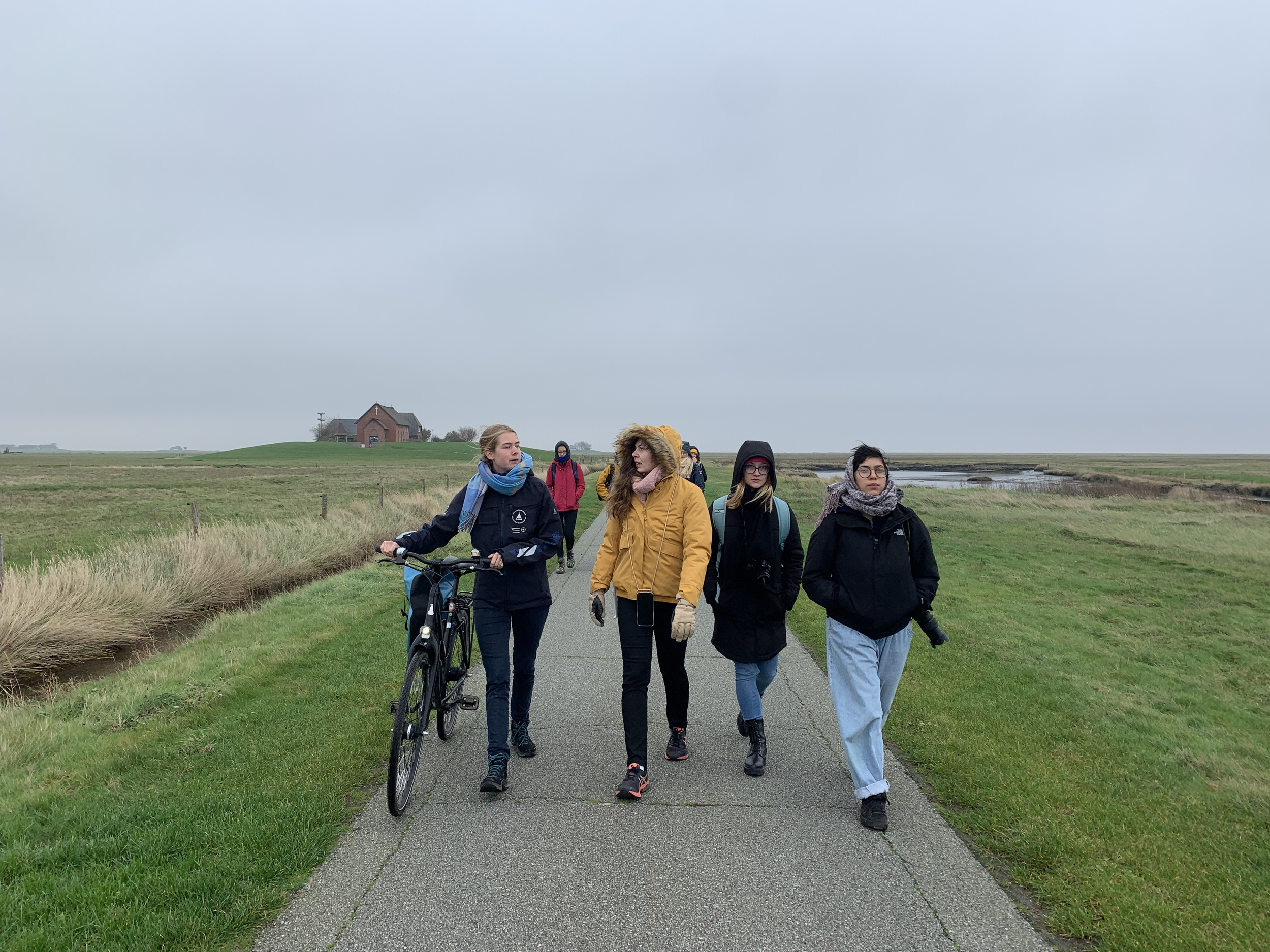Our team on one of our long walks on Langeneß, with a member from the Schutzstation Wattenmeer, while conducting research for the Museum am Rothenbaum (MARKK). We contributed to the exhibit “Water Messages,” which ran from February 25-October 31, 2023.
“Oceanic Feeling.” A film by Nina Moya Schreieder and Tabea Stumpe. The title was inspired by a 1927 letter to Sigmund Freud by Romain Rolland, who coined the term “oceanic feeling” to mean "a sensation of eternity,” a feeling of "being one with the external world as a whole."
“The Nis Puk” (Fog Maker). The image above was drawn by Boy Peter Andresen´s father. This fog story was told by Boy Peter Andresen. Interview by Mary Carlsen, Anja Binkowski, and Sarah Pohl.
“The Lost Women.” Fog story by Frerk Johansen. Interview by Mary Carlsen.
Waste Finds. By Sarah Pohl.
Boy Peter Andresen told us that the sea used to wash up many remarkable things, including archeological objects. Today, we find mostly plastic, glass and ghost nets that travel through waters from all over the world. The journey of this waste sometimes ends at the rocky edge of Langeneß. It was trapped by stones, hidden by kelp or buried under the Wadden Sea. Millions of animals die miserably every year as a result of environmental pollution. Waste enters their bodies through ingestion or causes other physical damage. Humans are also affected by the dangers of marine litter. It is in our hands to find adequate solutions for garbage disposal and thus protect the oceans and its creatures.
Langeneß schoolchildren and their visions of the future in light of climate change and rising seas. By Maya von der Behrens and Solveigh Gauditz. With thanks to the Langeneß school teacher, Lisa Bleß!
The Hallig of the future in 2052. By Jonna (10 years old).
Langeneß is connected with two Halligen (Hooge and Gröde) and one island (För) through streets. The streets won´t get flooded during a storm flood (they are protected from the water through stone dikes) but protrude from the water continuously. This is the reason why the Halligen and För are always connected with the mainland. The Hallig consists only of eleven dwelling mounds (Warften). The other dwelling mounds sunk because of a storm surge. This is why the names of the dwelling mounds changed as well. The dwelling mounds were adjusted to the rising sea level and were raised to nine meters. The Lorendamm was kept and connects Langeneß additionally to the mainland. The licenses to drive the Lore are still limited. The population rose to 130. The residents are still provided with groceries from the mainland by car. In a storm you can flip a lever on each terp and then a large glass dome goes up to the edge of our dwelling mounds so that you are protected as if you were in a snow globe.
The Halligen in 2112. By Mayke (14 years old).
According to my prediction there are three Halligen in 2112, called Neu-Langeneß, Neu-Hooge, and Neu-Gröde-Oland. Altogether there are 8 “climate-dwelling-mounds.” On one of these mounds, on Neu-Langeneß, we find a tide power plant. In the West behind Neu-Langeneß, we will find several wind turbines that produce energy for the Halligen. Each Hallig is protected by a dike which independently adjusts to the water level. From Neu-Gröde-Oland and Neu-Langeneß one can drive to the mainland with the Lore (a small train). A ferry connection travels daily between the Halligen. During low tide one can walk by foot from one Hallig to another.
Living with Salt/Leben mit Salz. By Andrea Muehlebach
Vernissage!
The Halligen in 2082. By Tade (14 years old).
In the year 2082 the Halligen could look like this according to my imagination: The Islands and Halligen are larger and are all connected through a street. The streets are not flooded by the tides and storm surges. The Hallig Langeneß got a dike so that it doesn´t get flooded during a “land under.” The dike is approximately 12 meters high. New dwelling mounds were built on the Hallig. Altogether there are now 23 dwelling mounds on Langeneß. About 150 people live on Langeneß now. That´s about 50 people more than in 2022. The Hallig became a popular place of residence. Hallig Gröde sunk during a big storm surge, since it was not protected enough.
The Halligen in 2060. By Levke (11 years old).
My Hallig still consists of Langeneß and Nordmarsch. They have more dwelling mounds, altogether there are 20. The Loredamm and the pier remain the same. The shape of the Hallig changed a bit; they shrunk due to storms and “land under.” The mounds were raised to ten meters. There is a shopping mound where supermarkets and drugstores were build. The Hallig people can go shopping there. Furthermore, there is a swimming pool on the Hallig.
MA thesis by Anja Binkofski. “Das Meer (r)aushalten – Zukunftsplanung auf den Halligen im Zeitalter der Ungewissheit”: Winner of the Bremen Studienpreis!
NDR TV report on “Water Messages.”













